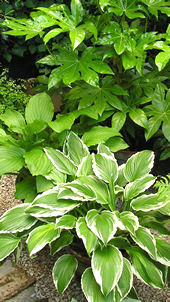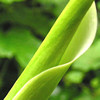"Some people think that to own a shady garden should be a matter for sympathy, but I always feel it is one for envy.
. . . If I had to choose between a sunny and a shady garden I would choose the shady one every time, not only for its peace and timelessness but also for the plants that can be grown in it. It seems to me that they are often more interesting and more beautiful than those that like to bask in the sun."
Margery Fish - Gardening in the Shade
There's a lot of shade in my garden, mainly because it's a small town garden, with several trees, and attached to a tall Victorian house. Only the central area is open to the sun for most of the day, and then only in the summer months.
The shade for much of the year is created by the sun not being high enough to reach over the rooftops, and later, though the sun is high in the sky, the tree canopy blocks much of the light. So I guess that almost all of it is in what the gardening books call 'partial shade'. But over the years I've realised that just following the guidance in books isn't enough - I needed to watch the changes in light through the year, and experiment.
Loving green
Shade isn't all the same, my reading informed me. Though the reading was useful, I could only develop an understanding of shade through seeing the effects of different types of shade in my own garden.
The shade created by buildings in small town gardens seems difficult to deal with at first, particularly in summer when we imagine bright summer flowers - most of which aren't happy in the shade. But green is a colour too, of course, and leafy plants can be just as invigorating as bright summer flowers. The lush growth of the warmer months, even if it is just green, lets you know that it is summer. There are so many shades and forms of green plants, and gardens that concentrate on shape and form, in all the various shades of green, always look inviting.
The corners
There are two areas of the garden that are particularly shaded - one mainly overshadowed by the house, and one mainly by trees. 'Kitchen Corner' (so called because, as you might have guessed, it runs alongside the kitchen) faces east, so gets some sun in the morning, but the house itself, to the south of this area, blocks out most of the direct light for most of the day. Woodland Corner, at the other end, has overhead shade from the trees in the summer. In spring it is full of flower, and later fills with green, with the occasional white flower. In both the shady corners in my garden I've decided to concentrate on foliage, in its many different hues, and to think about form and shape for interest, rather than lots of colour.
After the rather overwhelming shade of my first backyard garden, I never thought I'd enjoy shady areas. Yet planting up Woodland Corner and Kitchen Corner, in this garden, with shade-loving plants, transformed my attitude to shade.

The most helpful book I've read on gardening in the shade:
The
Complete Shade Gardener by George Schenk

Above: Foliage plants in Kitchen
Corner
Top left: Unfurling flower of arum lily.

